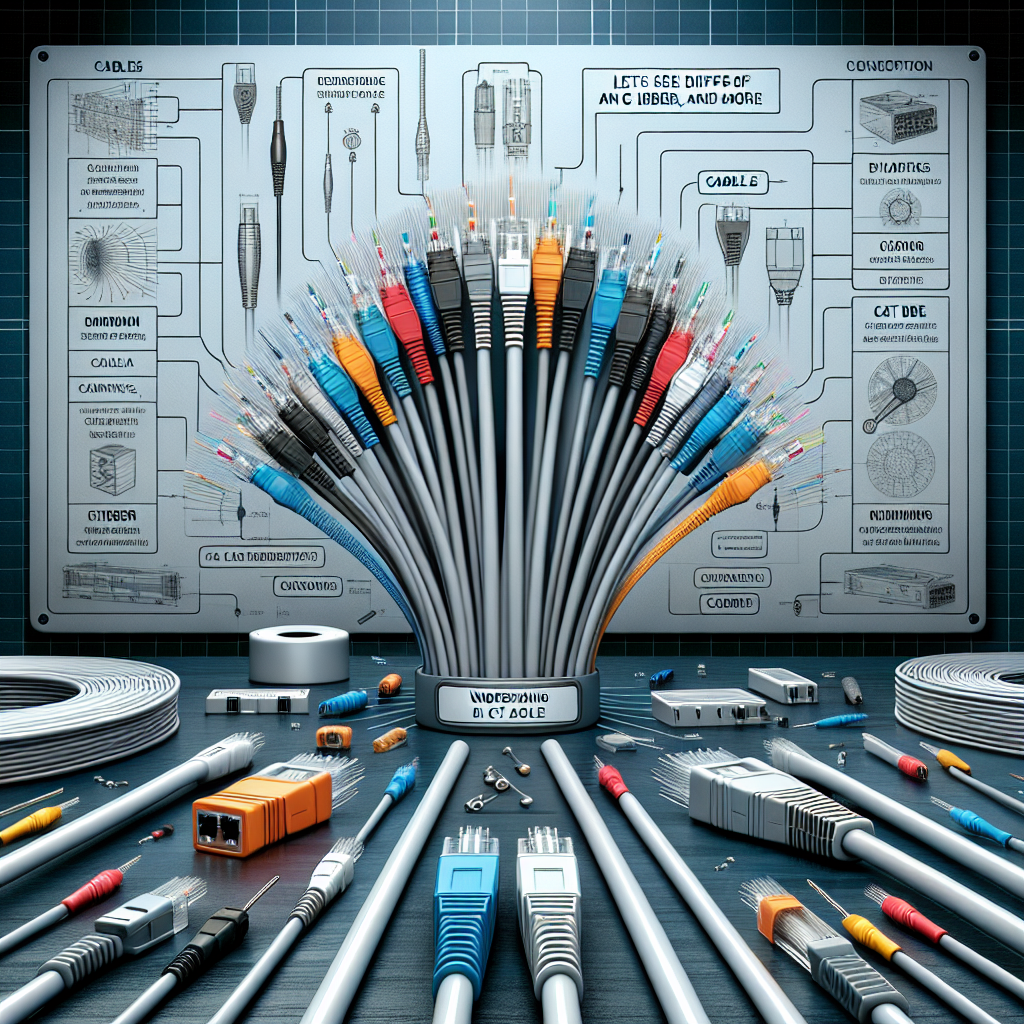In today’s highly connected world, understanding the types of cabling available is crucial for industries, businesses, and homeowners alike. The physical medium through which data travels can greatly impact the speed, quality, and reliability of communications. This article delves into the various cabling types, including Ethernet cables (CAT), fiber optic cables, coaxial cables, and more, providing insights into their specifications, advantages, and typical applications.
Types of Cabling
1. Ethernet Cables (CAT)
Categories:
The most widely used Ethernet cables are categorized as CAT (Category) cables. Each category comes with specific capabilities concerning bandwidth and speed:
- CAT 5e: Supports up to 1 Gbps (Gigabit) speeds and a bandwidth of 100 MHz. It’s suitable for most home and small office networks.
- CAT 6: Offers bandwidth up to 250 MHz and supports speeds of up to 10 Gbps for short distances (up to 55 meters).
- CAT 6a: An augmented version that doubles the bandwidth to 500 MHz and supports 10 Gbps over longer distances (up to 100 meters).
- CAT 7 and CAT 8: Designed for data centers and high-performance networks, they support frequencies of up to 600 MHz and 2000 MHz, respectively, with 10 Gbps and 25-40 Gbps speeds.
Applications:
Ethernet cables are primarily used for local area networking (LAN), connecting computers, routers, switches, and other network devices.
2. Fiber Optic Cables
Types of Fiber:
-
Single-mode Fiber (SMF): This type of fiber has a small core diameter (about 9 micrometers) and is capable of transmitting signals over long distances (up to 40 kilometers or more) with minimal signal loss. SMF is ideal for applications requiring long-distance data transmission, like telecommunications and internet backbones.
- Multimode Fiber (MMF): With a larger core diameter (about 50 or 62.5 micrometers), MMF is designed for shorter distance communication, typically within a building or campus (up to about 300 meters). It is easier and cheaper to manufacture but suffers from modal dispersion, which can impact performance in longer runs.
Applications:
Fiber optic cables are commonly used in high-speed internet infrastructure, data centers, and backbone connections due to their high bandwidth capabilities and immunity to electromagnetic interference.
3. Coaxial Cables
Coaxial cables are reliable for data and video transmission. They consist of a central conductor, an insulating layer, a metallic shield, and an outer cover. This design helps protect against electromagnetic interference (EMI).
Types:
-
RG-6: Used in cable television distribution and broadband internet, RG-6 cables have better shielding compared to RG-59 and can carry high-frequency signals.
- RG-59: Commonly used for low-frequency applications like closed-circuit television (CCTV) systems.
Applications:
Coaxial cables are often used in cable television, satellite television, and broadband internet connections.
4. Telephone Cables
Traditional phone systems use twisted-pair cables, commonly referred to as telephone lines. These cables come in unshielded twisted pairs (UTP) and shielded twisted pairs (STP).
-
UTP: Most commonly used for standard telephone lines and modest data transfer.
- STP: Offers additional shielding against interference, which is beneficial in environments with significant electromagnetic noise.
Applications:
Mostly found in telephony systems and low-speed data applications.
5. HDMI Cables
While primarily known for video transmission, HDMI (High Definition Multimedia Interface) cables can also carry audio and control signals. They transmit high-definition video and multi-channel audio over a single cable, making them popular in home theater setups, gaming consoles, and more.
Applications:
Used to connect TVs, monitors, projectors, and various entertainment systems.
Factors to Consider When Choosing Cabling
When deciding on the type of cabling for a specific application, several factors come into play:
-
Distance Requirements: The extent of the run will determine which type of cabling is appropriate. For long distances, fiber optics are generally preferred, while CAT cables are suitable for shorter runs.
-
Speed and Bandwidth: Consider the data transmission speed needed. Higher category Ethernet cables or fiber optics will better serve high-speed needs.
-
Interference Levels: In environments with a lot of electronic interference, fiber optics or shielded cables may be necessary to maintain signal integrity.
-
Cost: Budget constraints can influence the choice of cabling, as fiber optics tend to be more expensive than copper cable alternatives.
- Future Proofing: Investing in higher-rated cabling may reduce the need for future upgrades as technology evolves.
FAQs
1. What is the maximum length for CAT cables?
For CAT 5e, the maximum length is generally 100 meters for optimal performance. Longer runs, particularly for higher categories, may result in signal degradation.
2. Can I mix different types of cables in my network?
While it’s possible to mix cable types, it’s essential to ensure compatibility in terms of speed and connections. It may also introduce bottlenecks if lower-rated cables are used in conjunction with higher-rated ones.
3. Do I need to worry about signal loss with fiber optic cables?
Fiber optics have significantly less signal loss than copper cables. However, bends and excessive length can impact performance, so proper installation is crucial.
4. What makes fiber optics superior to traditional cables?
Fiber optics offer higher bandwidth capabilities, long-distance data transmission without significant loss, and immunity to electromagnetic interference, making them ideal for high-speed and high-volume data environments.
5. Is it necessary to use shielded cables?
Shielded cables can reduce interference in electrically noisy environments. If you face issues with data integrity or have critical applications, investing in shielded cables is advisable.
In conclusion, understanding the different types of cabling—CAT, fiber optics, coaxial, and more—allows individuals and businesses to make informed decisions that can enhance their communication needs. With the right cable choice, it’s possible to create a robust, efficient, and high-speed network suitable for today’s demands.


